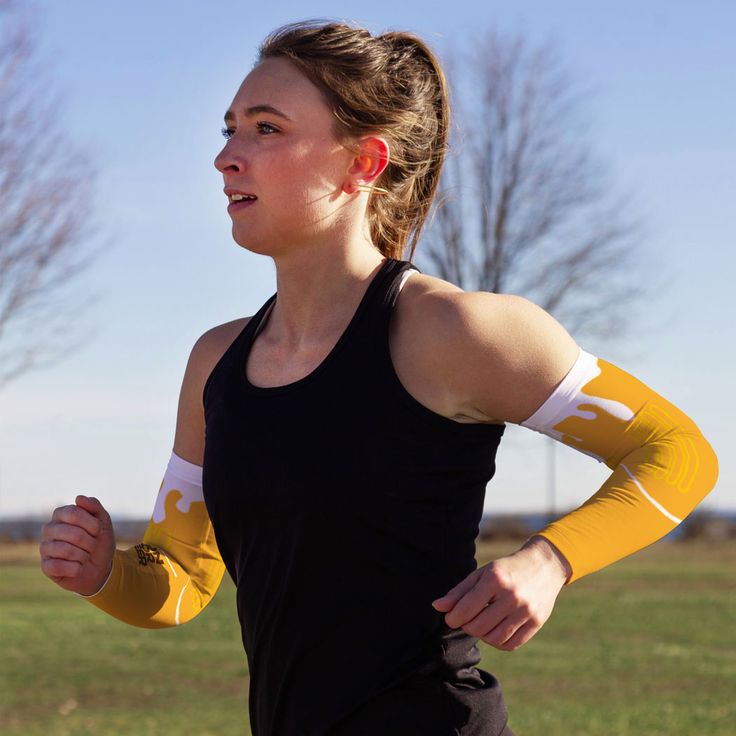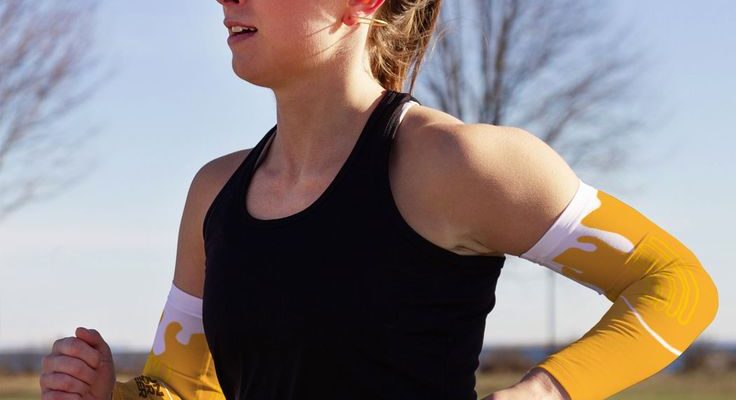What Are Arm Sleeves?
Why do runners wear arm sleeves? Arm sleeves are garments designed to cover the arms, extending from the wrist to the upper arm. Runners often use these sleeves for support during their workouts and races. These accessories are lightweight, versatile, and serve multiple purposes. They help improve performance, protect the skin, and provide comfort during runs.

Types of Arm Sleeves Available for Runners
- Compression Sleeves
- Boost Muscle Support: Compression sleeves are designed to apply pressure to the muscles in the arms, helping to stabilize them during rigorous activity. This support can lead to improved performance.
- Reduce Fatigue: By enhancing blood circulation, compression sleeves help reduce muscle fatigue. Runners often notice they can maintain their energy levels for longer periods when using these sleeves.
- Aid Recovery: After a run, wearing compression sleeves can promote faster recovery by minimizing soreness and improving the body’s ability to heal.
- Thermal Sleeves
- Provide Warmth: Thermal arm sleeves are specifically fashioned to retain body heat, making them ideal for colder weather. They keep the muscles warm, reducing the risk of strains during winter training sessions.
- Comfort in Cold Conditions: Runners can maintain comfort and avoid distractions caused by cold arms. This allows them to focus fully on their workout, even in chilly environments.
- Layering Option: These sleeves can be layered under jackets or outerwear, providing flexibility in dressing for changing weather conditions.
- UV-Protective Sleeves
- Shield Against Harmful Rays: UV-protective sleeves are crafted from materials that block harmful ultraviolet (UV) rays from the sun. This feature is crucial for preventing sunburn during outdoor runs.
- Long-Term Skin Protection: Regular use of UV sleeves can protect the skin from long-term damage, reducing the risk of skin conditions caused by excessive sun exposure.
- Cool and Comfortable: Many UV sleeves are made from breathable materials that keep the arms cool, helping runners stay comfortable while still receiving sun protection.
Popular Materials Used in Arm Sleeves
Manufacturers use various materials to ensure arm sleeves are both effective and comfortable. Spandex is common for its stretchable and breathable qualities, offering a snug fit. Nylon is chosen for its durability and lightweight nature, ideal for long-lasting use. Polyester blends are preferred for their moisture-wicking properties to keep skin dry. Some sleeves include mesh panels to improve airflow and comfort during intense runs.

Benefits of Wearing Arm Sleeves While Running
Why do runners wear arm sleeves? Arm sleeves offer numerous advantages for runners. These benefits enhance performance, comfort, and safety during runs. Let’s explore how they can improve your running experience.
Improved Muscle Support and Compression
Compression arm sleeves provide excellent muscle stabilization during runs. They reduce vibrations and prevent muscle fatigue. By supporting the muscles, they decrease the risk of injuries caused by overuse. The compression also helps optimize energy efficiency during intense exercises.
Enhanced Blood Circulation and Recovery
Arm sleeves improve blood flow to the arms. Better circulation helps deliver oxygen and nutrients to muscles. This reduces the build-up of lactic acid, which can cause fatigue. Enhanced circulation also speeds up post-run recovery, minimizing soreness.
Protecting Against Sunburn and UV Rays
Many arm sleeves feature UV protection, shielding your skin from harmful sun rays. They reduce the risk of sunburn during outdoor runs. This makes them an essential accessory in hot, sunny climates. You’ll stay comfortable while maintaining healthy skin.
Temperature Regulation During Runs
Arm sleeves help in regulating body temperature during runs. Thermal sleeves keep you warm during chilly weather. In hotter conditions, moisture-wicking arm sleeves cool your arms by drawing sweat away. This ensures comfort in various weather scenarios.
How Arm Sleeves Help Prevent Injuries
Arm sleeves can play a crucial role in preventing injuries for runners. Their benefits go beyond comfort and style, focusing on safeguarding your muscles and promoting recovery after runs.
Reducing Muscle Fatigue and Strain
Compression arm sleeves stabilize arm muscles during repetitive movements. They minimize muscle vibrations caused by running. These vibrations, over time, can lead to fatigue and strain. By supporting the muscles, sleeves reduce chances of overuse injuries. They help runners push through long distances without overloading their limbs. Arm sleeves also distribute pressure evenly, preventing unnecessary stress on the muscles. This efficiency keeps runners performing at their best for a longer duration.

Managing Swelling and Inflammation
Inflammation can slow down runners after a strenuous workout or race. Arm sleeves help by promoting better circulation to reduce swelling. Compression technology encourages blood flow, which carries nutrients to the muscles for healing. Improved circulation prevents fluid buildup in tissues, a direct cause of swelling. Sleeves also provide a gentle, comfortable compression that soothes inflamed areas. For runners prone to arm pain or discomfort, arm sleeves can be an effective tool for faster recovery.
Style and Practicality of Arm Sleeves
Arm sleeves are not just functional for runners but are also stylish and practical. They combine aesthetics with utility to enhance both performance and appearance. Let’s explore why they appeal to runners beyond their health benefits.
Trendy Designs and Customization Options
Modern arm sleeves come in various trendy designs, patterns, and colors to suit personal styles. Runners can choose designs that match their apparel or stand out with bold colors. Some brands even allow customizations like personalized logos or text. This makes arm sleeves a perfect mix of self-expression and practicality. Trendy designs also encourage runners to wear them more frequently during workouts or races.
Storage Features for Convenience
Some arm sleeves include pockets for additional convenience. These hidden or external pockets are perfect for carrying small essentials, such as keys, energy gels, or cash. For runners who prefer minimalist gear, these sleeves help reduce the need to carry extra bags. Such storage options are especially useful during long-distance runs or marathons. Combining storage with functionality enhances their overall value for active individuals.
Situations Where Arm Sleeves Are Most Effective
Why do runners wear arm sleeves? Arm sleeves prove handy in various running scenarios. They enhance performance, comfort, and safety based on conditions. Let’s look at when they are particularly beneficial for runners.

Long-Distance Runs
Long-distance runs can strain your muscles and cause fatigue. Arm sleeves support your muscles during these intense workouts. Compression sleeves stabilize muscles, reducing vibrations caused by repetitive arm movement. This prevents fatigue and lowers the risk of injuries. Sleeves with storage pockets also help carry small essentials like energy gels. This convenience is especially useful during marathons or ultra-runs. For long distances, arm sleeves enhance efficiency and reduce physical strain.
Cold or Hot Weather Conditions
Arm sleeves offer seasonal adaptability, making them effective in both cold and hot weather. Thermal arm sleeves provide insulation in chilly temperatures, keeping your arms warm. This is particularly beneficial for winter training or early-morning runs. In hot weather, sleeves with UV protection shield your skin from harmful rays. Moisture-wicking materials draw sweat from your arms, promoting a cooling effect. This keeps you comfortable and protected regardless of the temperature.
Post-Workout Recovery Sessions
Recovery is key after intense workouts. Arm sleeves assist by promoting better blood circulation. Compression sleeves reduce swelling and inflammation, accelerating muscle recovery. They help eliminate lactic acid build-up, easing arm soreness after runs. Wearing them post-workout speeds up healing, making them a valuable recovery tool. Whether you’re nursing sore muscles or prepping for your next run, arm sleeves ensure faster recovery and comfort.
Tips for Choosing the Right Arm Sleeves
Selecting the right arm sleeves can enhance your running experience and provide maximum support. Consider key factors like fit, activity level, climate, and budget to make the best choice.
Finding the Perfect Fit
A proper fit ensures comfort and effectiveness. Arm sleeves should be snug but not restrictive. Measure your arm’s circumference and length to determine the correct size. Stretchable fabrics like spandex help achieve a comfortable fit for most runners. If the sleeves are too tight, they may hinder blood flow, while loose sleeves won’t provide adequate support. Check size charts from manufacturers to match your arm dimensions.
Choosing Based on Activity Level and Climate
Consider your running activities and weather conditions before picking arm sleeves. For intense runs or long distances, compression sleeves are ideal for reducing muscle fatigue. UV-protective sleeves are best for outdoor runs under the sun. Thermal sleeves provide warmth for winter training or cold mornings. Moisture-wicking materials help in hot climates by keeping your skin dry and cool. Select sleeves that adapt well to specific conditions for optimal performance.
Budget-Friendly vs. Premium Options
Arm sleeves come in a range of prices to suit different budgets. Budget-friendly sleeves often use simple materials like nylon and spandex. These options can be effective for casual or moderate runners. Premium sleeves offer advanced features like mesh panels, UV protection, or storage pockets. They’re ideal for athletes who demand the best performance and durability. Consider how often you’ll use the sleeves and your level of commitment to running when deciding between budget and premium options.

Common Misconceptions About Arm Sleeves
Arm sleeves are widely used by runners, but misconceptions can deter some from trying them. Addressing these misunderstandings can help runners make informed decisions about their benefits.
Are They Necessary for All Runners?
Arm sleeves are not mandatory for every runner. They are tools that enhance performance and comfort. Casual runners may not notice significant benefits during short runs. These sleeves are most effective for long distances, recovery, or extreme weather conditions. Runners benefit more when they match sleeves to their specific needs. For example, compression sleeves help endurance athletes, while UV-protective sleeves suit outdoor joggers. Whether arm sleeves are “necessary” depends on your personal running goals and environment.
Addressing Concerns About Comfort and Restriction
Some runners worry that arm sleeves feel tight and restrictive. Properly fitted sleeves should feel snug but comfortable. They shouldn’t hinder movement or blood flow. Lightweight materials like spandex and nylon ensure flexibility and breathability. Runners should measure their arms to find the right size. Loose sleeves won’t offer proper support, while overly tight ones can cause discomfort. Modern designs emphasize comfort without sacrificing functionality. Testing different styles can help runners discover sleeves that suit their preferences best.
Maintenance and Care for Running Arm Sleeves
Proper maintenance ensures arm sleeves remain effective and last longer. Taking care of them is simple but essential. Follow these guidelines to maintain their quality and performance.
Washing and Storing Guidelines
- Hand Wash for Best Results: Hand wash arm sleeves in cold water with mild detergent. Avoid harsh soaps or bleach.
- Machine Wash with Care: Use a gentle cycle if machine washing. Place sleeves in a mesh laundry bag. This prevents stretching or tearing.
- Air Dry Only: Do not use a dryer. Heat can damage the material or affect elasticity. Lay the sleeves flat to air dry.
- Avoid Fabric Softeners: Fabric softeners can impact moisture-wicking properties. Stick to a simple detergent instead.
- Store in Cool, Dry Places: Keep arm sleeves away from direct sunlight or damp areas. Fold them neatly or roll them up for compact storage. Proper storage prevents wear and deformation.
Prolonging the Lifespan of Your Arm Sleeves
- Rotate Multiple Pairs: Use different pairs of arm sleeves to reduce prolonged wear. This helps prevent overuse.
- Inspect for Tears: Regularly check for small tears or areas of wear. Fix them to prevent further damage.
- Avoid Overstretching: Pull on sleeves gently when wearing or removing them. Overstretching can weaken elasticity.
- Wash After Every Use: Sweat and dirt buildup can degrade materials. Cleaning after every run maintains their performance.
- Follow the Manufacturer’s Instructions: Always read the care label for specific washing and maintenance tips. Adhering to this ensures you get the best out of your sleeves.
Caring for your arm sleeves properly not only improves their effectiveness but also saves money. Durable sleeves mean you won’t need frequent replacements, making them worth the effort.
Conclusion: The Growing Popularity of Arm Sleeves
In conclusion, the question of why do runners wear arm sleeves reveals several compelling reasons. From the science of compression and temperature regulation to the fashionable appeal and versatility, arm sleeves present significant benefits for runners in 2025 and beyond.
Whether you’re an experienced runner or just starting, experimenting with arm sleeves can enhance your experience. As they continue to gain popularity, understanding their benefits equips you to make informed decisions about your running gear. Make the most of your training and performance while enjoying the style and features that arm sleeves provide.
